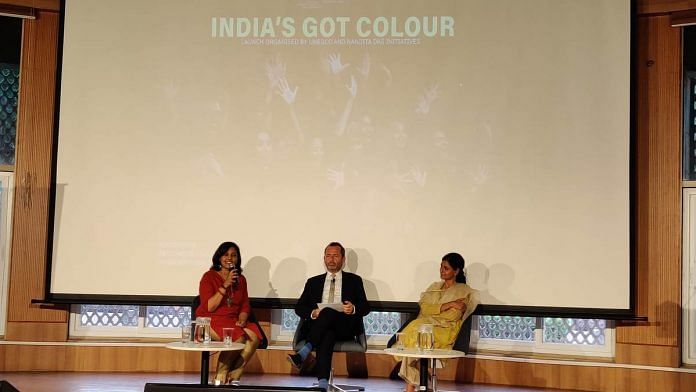New Delhi: “Even in our Hindi film songs, you hear ‘gore gore gaal’ or ‘gori kalaiyaan,’ wherein being fair is almost a synonym for being beautiful,” actor-producer Nandita Das said to a room full of school students on Monday.
“I remember almost every article about me would start with ‘dark and dusky Nandita Das’ – as if they had to qualify that she’s dark and yet she’s an actor.”
At the UNESCO cluster office in New Delhi’s Chanakyapuri last evening, the critically-acclaimed artist was launching the India’s Got Colour campaign — an initiative aimed at addressing the deep-rooted colour bias in the country. In collaboration with UNESCO, represented by Director Eric Falt on the panel, as well as the founder-director of Women of Worth (WOW) Kavitha Emmanuel, the campaign began with a two-minute music video released on 25 September.
“Skin colour bias is simply racism by any other name. It must be confronted just like any other form of bigotry,” Falt said, setting the stage for a conversation that meandered between societal notions of beauty, the adoption of a colonial mindset and the role of the media in reinforcing certain stereotypes.
“The word colourism,” Emmanuel said, “was introduced by a novelist named Alice Walker, who won the Pulitzer Prize. It is the concept of discriminating on the basis of skin colour within your own ethnic group — we discriminate among ourselves,” she said, adding that while she can’t identify a single point of origin for the bias, “several reasons like the colonial mindset, the caste system, and the difference between the rich and the poor and their exposure to the sun by virtue of the kind of work they do, can all be reasons to understand why it sustained”.
Emmanuel started the Dark Is Beautiful campaign in 2009, with Das joining in a supporting role four years later. To celebrate its 10th anniversary, the campaign was reinvented to be more inclusive, giving rise to the India’s Got Colour title.
To battle colourism at the ground level, Emmanuel’s government-registered NGO is taking the message to “the millenial and gen Z generation, because they’re the future — open-minded and willing to change their worldview,” she told ThePrint.
Campaign plans included translating the Das-produced music video into multiple languages so that it can be accessible across regions and demographics. WOW also has plans to introduce modules for schools and colleges, make a counselling service available for victims of discrimination and continue spreading the message through social media and educational workshops.
The next step would be to build more capacity for the campaign itself, Emmanuel said, “which will involve getting many people and organisations involved, including politicians, sportspersons, and influential people in our country running with this campaign”.
Also read: Billie razor’s ‘real body hair’ ad is insidious, harmful and exploitative
India’s obsession with fair skin
Just last week, Bollywood actor Bhumi Pednekar appeared in a poster and trailer of the film Bala with make-up evidently intended to make her appear darker. ‘Brownface’ has been historically known to be used by racially dominant groups to stereotype, mock and reduce people of colour into oppressive caricatures.
The irony of an Indian wearing brownface didn’t escape anyone, as people on Twitter asked if “there was a lack of brown girls in India”. The producers of Hrithik Roshan’s Super 30 were asked the same questions when his face was darkened so people could believe he was a man from Bihar.
if only there were any actors in this country with darker skin… if only.#BrownFace #Bala pic.twitter.com/baks9OaeFw
— Karnika (@KarnikaKohli) October 10, 2019
“When there is a role of a rural woman, or a Dalit woman, or a role of a slum-dweller, then my skin colour is fine,” Das told audiences. “But the minute I have to play an educated, upper-middle-class character, invariably someone comes up to me and says ‘I know you don’t like to lighten your skin, but you know this role is of an upper-middle-class educated person’.”
“Outside India, they don’t really understand how a country that is largely dark would actually be discriminating against itself,” she added.
By 2020, the skin-lightening industry is set to mushroom into a $23 billion business globally, according to a report from Global Industry Analysts. Even 10 years ago, an AC Nielsen report estimated that India alone accounts for $432 million worth of skin-whitening products being consumed annually — “with a considerable chunk of this revenue earned by Unilever’s best-selling Fair & Lovely product”, Maliha Rehman reported for the Business of Fashion in London.
All 12 Miss India finalists this year were fair, thin and tall, and even the men’s fairness cream market is anticipated to grow with a compound annual growth rate (CAGR) of 6-8 per cent during the forecast period of 2018-2023.
Miss India contestants. They all have the same hair, and the SAME SKIN COLOUR, and I'm going to hazard a guess that their heights and vital stats will also be similar. So much for India being a 'diverse' country. pic.twitter.com/L4yXG0WvRu
— labellagorda (@labellagorda) May 27, 2019
“No one thing ever changes a mindset. It changes so gradually — it’s when a number of things happen simultaneously over a period of time that in 10 years, you might be able to see an attitude change,” said Das.
“And art,” she later added, “if art did not create change, why would people derecognise it? Why do people ban films or censor things? Because they know that the impact of art and cinema is that it goes into your subconscious without you realising it. It does challenge prejudices.”
“Just as stereotypes get formed because of images, they can also be broken by them.”
Also read: In the name of Hinduism, people are boycotting tea, food, fashion, detergent and all logic






